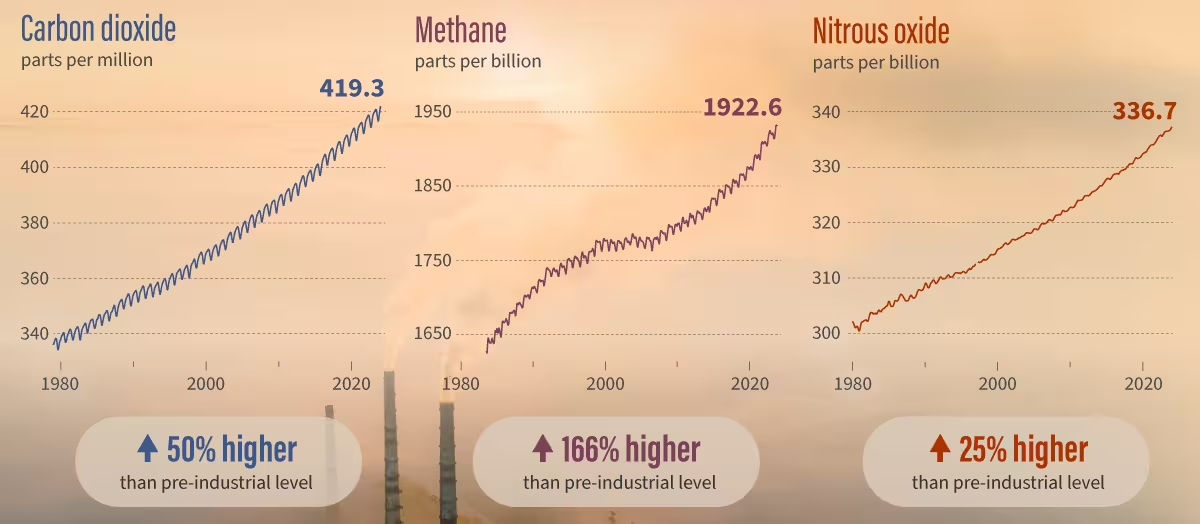State of the Climate report confirms record-high temperatures, GHGs in 2023
26 August 2024
Greenhouse gas concentrations, the global temperature across land and the ocean, and ocean heat content all reached record highs in 2023, according to the 34th annual State of the Climate report.
The international annual review of the world’s climate, led by scientists from NOAA’s National Centers for Environmental Information (NCEI) and published by the Bulletin of the American Meteorological Society (BAMS), is based on contributions from nearly 600 scientists in 60 countries. It provides a comprehensive update on Earth’s climate indicators, notable weather events and other data collected by environmental monitoring stations and instruments located on land, water, ice and in space.

The three dominant greenhouse gases in Earth’s atmosphere—carbon dioxide (left), methane (center), and nitrous oxide (right)—all reached new highs in 2023. (NOAA Climate.gov image, adapted from Figure 2.59 in State of the Climate in 2023.)
Notable findings from the State of the Climate Report report include:
-
Record temperatures notable across the globe—A range of scientific analyses indicate that the annual global surface temperature was 0.55 to 0.60°C above the 1991–2020 average. This makes 2023 the warmest year since records began in the mid-to-late 1800s, surpassing the previous record in 2016. The global surface temperature for 2023 was also 1.35–1.54°C above the 1850–1900 average, a period commonly used to represent pre-industrial conditions.
The transition in the Pacific Ocean from La Nina at the beginning of the year to a strong El Niño by the end of the year contributed to the record warmth. All seven major global temperature datasets used in the report agree that the last nine years (2015–2023) were the nine warmest on record. On a trend-adjusted basis, 2023 was well above the trend in all seven datasets, exceeding the 90th percentile in each.
- Earth’s GHG concentrations were the highest on record—Carbon dioxide, methane and nitrous oxide—Earth’s major atmospheric greenhouse gases—once again reached record high concentrations in 2023. Annual growth in global mean CO2 has increased from 0.6 ± 0.1 ppm per year in the early 1960s to an average of 2.5 ppm per year during the last decade of 2014–2023.
- El Niño contributed to record-high sea surface temperatures—El Niño conditions in the equatorial Pacific Ocean emerged in boreal spring 2023 and strengthened throughout the year. The mean annual global sea-surface temperature in 2023 was record high, surpassing the previous record of 2016 by 0.13°C. Each month from June to December was record warm. On August 22, 2023, an all-time high globally averaged daily sea-surface temperature of 18.99°C was recorded.
- Ocean heat and global sea level were the highest on record—Over the past half-century, the ocean has stored more than 90% of the excess energy trapped in Earth’s system by greenhouse gases and other factors. The global ocean heat content, measured from the ocean’s surface to a depth of 2000 m, continued to increase and reached new record highs in 2023. Global mean sea level was record high for the 12th-consecutive year, reaching about 101.4 mm above the 1993 average, when satellite altimetry measurements began.
- Heatwaves and droughts contributed to massive wildfires around the world—During late spring and a record-warm summer, approximately 37 million acres burned across Canada, more than double the previous record from 1989. Millions of acres of bushfires burned for weeks in the Northern Territory of Australia during September and October. In 2023, the European Union’s largest wildfire since the start of the record in 2000 burned hundreds of thousands of acres in Greece from mid-August to early September.
- The Arctic was warm and navigable—The Arctic had its fourth-warmest year in the 124-year record, with summer (July to September) being record warm. The seasonal Arctic minimum sea-ice extent, typically reached in September, was the fifth-smallest in the 45-year record. The amount of multiyear ice—ice that survives at least one summer melt season in the Arctic—continued to decline. Since 2012, the Arctic has been nearly devoid of ice that is more than four years old.
The State of the Climate report is a peer-reviewed series published annually as a special supplement to the Bulletin of the American Meteorological Society.
Source: NOAA